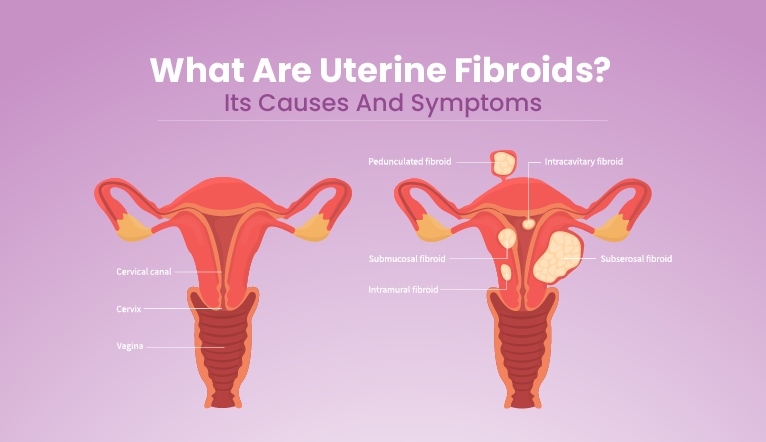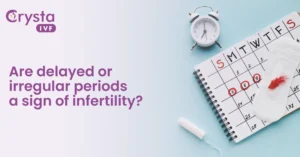Uterine fibroids also known as leiomyomas or myomas are tumours or abnormal growth of cells in the uterus. The uterus is the hollow muscular organ in the female body.
About 70% – 80% of women develop fibroids at any point in their life. The uterine fibroids are reported among women 30-40 years of age and are benign (will not lead to cancer). They can vary in size, shape, characteristics, and structures.
Women often have uterine fibroids or uterus fibroids, but you might not even notice them since they usually don’t cause symptoms, and they stay hidden in the uterus.
What are the causes of uterine fibroids?
The cause for the growth of uterine fibroids is still unknown, but experts and researchers have mentioned some of the factors that can lead to the formation of fibroids.
Some of them are:
- Stress
- Deficiency of vitamin D
- Hormones such as estrogen and progesterone promote uterine fibroids
- Genetic changes
- Growth hormone
What are the symptoms of uterine fibroids?
The symptoms of uterus fibroid vary from one case to another.
Although most fibroids don’t cause any symptoms and stay hidden in the uterus, the larger leiomyomas can cause several symptoms.
Additionally, it isn’t necessary to share the same symptoms with someone who is experiencing them.
Some of the common symptoms seen are-
- Prolonged periods
- Heavy menstrual flow
- Anemia
- Bleeding between periods
- Lower back and pelvic pain
- Feeling of tiredness
- Frequent urination
- Vaginal discharge
- Pain during sex
- Constipation
How are uterine fibroids diagnosed?
Uterine fibroids are hidden in the uterus and are mostly diagnosed accidentally by your gynecologists during routine pelvic checkups.
Other than pelvic checkups, here are some diagnostic tests that confirm the diagnosis of uterus fibroids.
The most common tests for uterine fibroids are:
Ultrasound :
It is a quick, accurate, and safe scan to diagnose your fibroids. Your doctor will place the ultrasound probe on the lower abdomen or through the vagina to scan the uterus and ovaries.
MRI :
MRI shows the shape, size, and location of the fibroid and is more expensive than ultrasound. Not all women with fibroids require MRI.
Your doctor may suggest additional tests if unable to find out the source of pain.
Laparoscopy :
Your doctor will insert a laparoscope (a thin, long instrument) that has a camera to see the uterus and surrounding structures.
Hysteroscopy :
Your doctor will insert an instrument with a camera to remove the suspected fibroids in the uterus.
Hysterosalpingogram :
Your doctor will place the catheter on the inner side of the uterus and fallopian tubes to confirm the uterine fibroids.
Hysterosonogram :
A catheter is injected with saline to look inside the uterus to confirm the uterine fibroids.
Who is at risk of developing uterus fibroid?
Uterine fibroids are most common in women of childbearing age, but other than that, several factors contribute to the development of leiomyomas among women, and they are;
- Age: About 70 – 80% of women develop fibroids at the age of 50, and the most common age is between 30 -40 years
- Obesity: Obesity is associated with an increased risk of developing uterine fibroids of 2- 3 times more than women under normal weight.
- Diet: Women who regularly eat fruits, green leafy vegetables, and vitamin D have less risk for fibroids than women who eat red meat and avoid plant-based diets.
- Family history: If your mother, sister, or any of your family members are exposed to uterine fibroids, you develop fibroids threefold higher than the average exposure.
- High blood pressure: Women with high blood pressure have an increased risk of developing uterine fibroids by about 40%.
- Race and ethnic origin: African-American women are at higher chances of developing fibroids than Caucasian women.
How are uterine fibroids treated?
Uterine fibroids are treated differently depending on their size, number, and location. If the fibroid is small in size and does not cause major symptoms, there is no need for treatment.
In contrast, if there are multiple fibroid growths, the fibroid is big, and there are symptoms such as bleeding, infertility issues, pain, etc., then treatment is required.
Treatments available for uterine fibroids:
- Symptomatic treatment
- Hormonal therapy to ease menstrual bleeding
- Gn-RH (Gonadotropin-releasing hormone) agonists are for severe anemia and heavy bleeding.
- An intrauterine device will reduce the bleeding caused by fibroids.
- Surgery to remove the uterine fibroid.
Is surgery required for leiomyomas or myomas?
There are several factors to consider before the surgical removal of uterine fibroid.
Along with the size, location, characteristics of growth, the most important factor before starting surgery is the wish for pregnancy.
As some surgical options preserve the uterus and only remove the uterine fibroid, some surgical options can either damage or remove the complete uterus.
Some of the common surgeries for uterine fibroids are:
Hysterectomy :
This procedure removes the uterus and provides a permanent solution to the fibroids.
Myomectomy :
This procedure is to remove fibroids without causing damage to the uterus. There are different types of myomectomies depending upon the location, size, and several fibroids.
Abdominal myomectomy:
Indicated if you have multiple and larger fibroids
Laparoscopic myomectomy:
Your surgeon will place a telescope on the incision to check the uterus, fallopian tubes, and ovaries. The fibroids are taken away through the long instrument placed on the incision.
Hysteroscopic myomectomy:
This procedure is for women with submucosal uterine fibroid.
Uterine artery embolization:
It is a new and alternative method for fibroid removal. This procedure will block the blood passing through the fibroids causing it to shrink and reduce the symptoms of heavy bleeding.
What are the preventive tips for uterine fibroids?
You can’t prevent fibroids, but you can reduce the risk factors by simple lifestyle changes and regular pelvic examinations.
The following measures will help you to reduce the risk:
- Stay hydrated by drinking plenty of water
- Eat fresh fruits and green leafy vegetables
- Maintain a healthy weight
- Avoid eating red meat
- Avoid high sugar foods
- Maintain vitamin-D with daily sun exposure
- If you are hypertensive, maintain blood pressure within the normal range
- Have regular intake of vitamin C and vitamin E rich foods
- Avoid beverages and food additives
How Crysta IVF can help in managing Uterine fibroids?
Crysta IVF can help infertile patients suffering from uterine fibroids achieve their dream of becoming a parent by understanding their medical history, cause of infertility etc. Our fertility experts identify leiomyomas, give you proper counselling, required treatment, education along with prevention measures, and regular follow-up.
As part of the fertility consultation, the doctors at Crysta IVF will screen your symptoms and give you the necessary counselling to best manage your symptoms and associated risks.
Conclusion:
Uterine fibroids are a common reproductive problem, showing no symptoms to challenging symptoms and affecting women’s quality of life. There are different treatment options available to treat the uterine fibroid.




